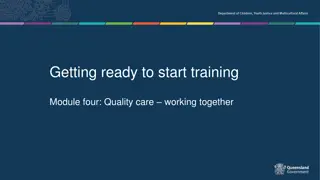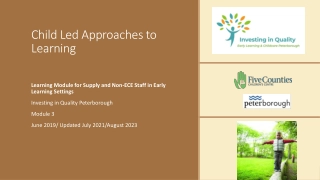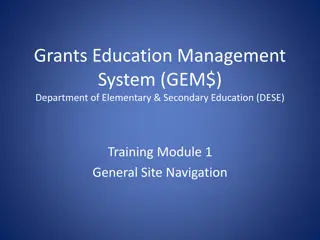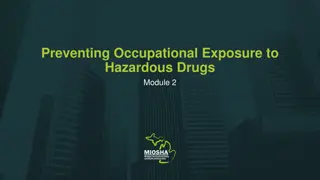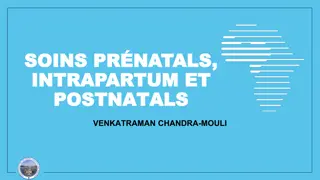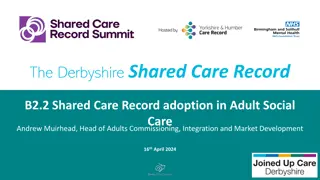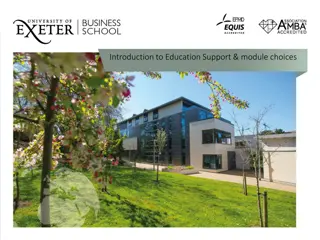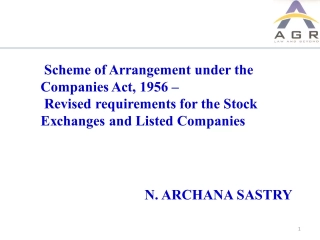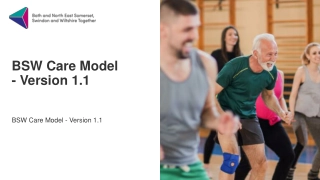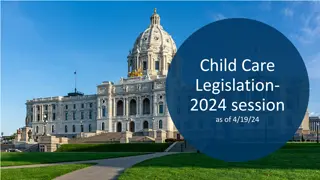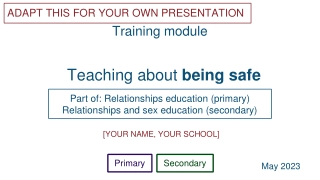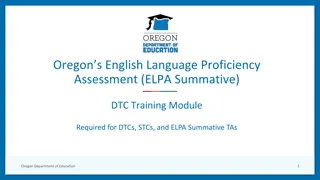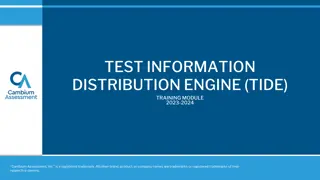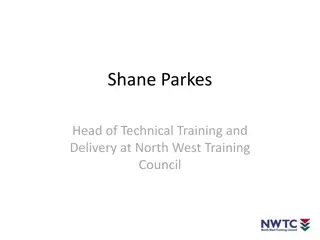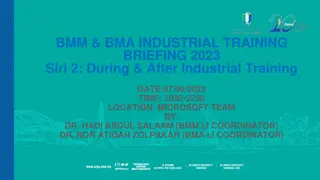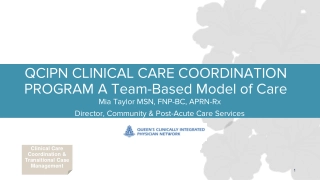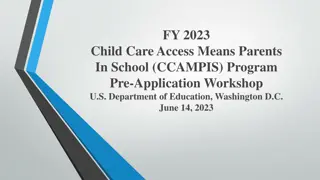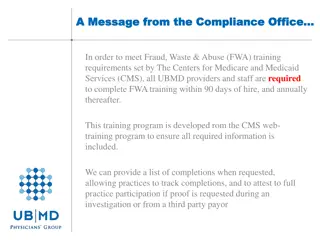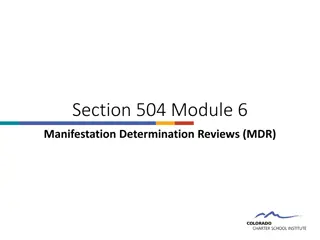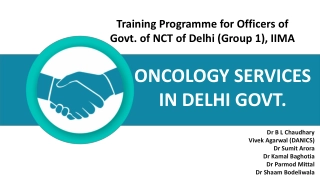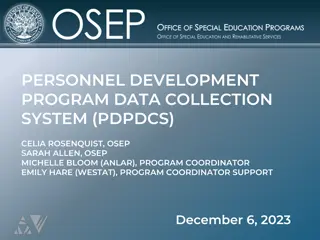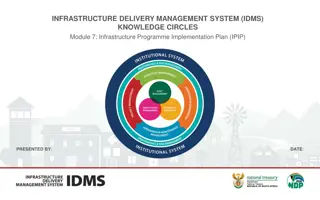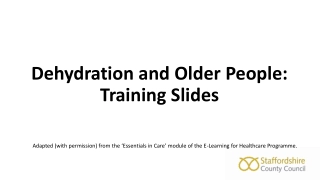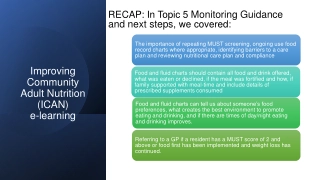Early Days in a Care Arrangement Training Module Overview
This training module focuses on the early days in a care arrangement, covering topics such as accepting a care arrangement, building relationships with children, privacy and confidentiality considerations, case planning, promoting a positive self-identity, and advocacy for children and young people. Participants will learn about key factors in decision-making, ways to support a child's self-identity, and the importance of advocacy. The module aims to equip individuals with the knowledge and skills needed to meet the physical, emotional, and social needs of children in care.
Download Presentation
Please find below an Image/Link to download the presentation.
The content on the website is provided AS IS for your information and personal use only. It may not be sold, licensed, or shared on other websites without obtaining consent from the author. Download presentation by click this link. If you encounter any issues during the download, it is possible that the publisher has removed the file from their server.
Presentation Transcript
Getting ready to start training Module three: Early days in a care arrangement
Getting ready to start training modules Each participant will be assessed throughout the four modules on the following learning objectives: Module one context of foster care - completed An understanding of the process of how children and young people come into care and the impact of this process, and why children and young people require a care arrangement. Module two understanding the past for a child or young person - completed An understanding of trauma and related behaviours for a child or young person who is in care arrangement. Module three early days in a care arrangement Developing knowledge and skills required to meet the physical, emotional and social needs of children and young people in care and an understanding of the importance of participation by children and young people and their families in decision making. Module four Quality care & working together Have an understanding of the importance of partnerships between children, their families, foster and kinship carers and workers, (both in the government and non-government sectors), and their roles and responsibilities when working together as a team.
Module three Early days in a care arrangement Learning outcomes module three At the end of this module you will be able to: Discuss the factors that would be taken into consideration in deciding whether to accept a care arrangement. Outline key factors in building a relationship with a child or young person while respecting their privacy. Demonstrate understanding of the framework for decision making in meeting a child or young person s protective needs. Demonstrate knowledge of ways to encourage a child or young person s sense of self and identity. Demonstrate understanding of advocacy for children and young people.
Module three: Early days in a care arrangement 1. Accepting a care arrangement 30 mins Activity What do I need to consider? 2. Building Relationships - 40 mins How to welcome a child or young person Helping a child or young person to settle in 3. Privacy and confidentiality 30 mins Obligations for carer s and the children and young people in their care. Maintaining a child or young person s privacy and confidentiality obligations Use of social media 4. Case Planning & Decision Making about how to meet a child or young persons needs 40 mins 5. Promoting a positive sense of self and identify for a child or young person 30 mins 6. Advocacy for children and young people 10 mins Activity
If your own child, or a child who is special to you (niece, nephew or child of close friend) had to live with someone else for a period of time: Activity 1. What would you expect the carer to provide for your child? 2. How would you as a family expect to interact with your child while they were being cared for by someone else? 3. What decisions would you be happy to let the carer make and what would you like to retain control over?
Care Arrangement Accepting a child or young person into your care
Care Arrangement What you need to know and consider Can I meet: The Charter of Rights Principles of the Act Statement of Standards Human Rights Act 2019 Briefly review the Charter of Rights and the Principles of the Act: Carefully consider each of the Statement of Standards provided to you Note down one way you could meet each Statement of Standard Are there any challenges you might face in meeting any of the Statement of Standards Discuss your answers or provide solutions to challenges
Accepting a care arrangement What you need to know and consider Foster Carer Agreement (FCA) A Foster care agreement or FCA is a written agreement negotiated between each foster carer, their foster and kinship care service and Child Safety to: set out the terms and responsibilities between the foster carer, their agency and Child Safety, including: Types of care arrangements the carer can and cannot provide care for i.e. primary, short-break (respite) or emergency The number of children/ young people you can provide care for Gender and age ranges of children and young people the carer can/cannot provide care for Your language and culture School catchment area The foster carers family support requirements Any additional supports and considerations required by a carer who provides other regulated care services from their home i.e. family day care. Plan for meeting the carer s ongoing development and support needs An FCA is approved by a CSSC Manager
Accepting a care arrangement What you need to know and consider Information provided to parents (Child Protection Act 1999 s85 & s86) When child or young person is placed into a care arrangement, by law their parent is to be provided with your carer details when it has been assessed by Child Safety as safe to do so. Where Child Safety have determined via a risk assessment that carer details can be provided, Child Safety will also determine the level of information provided to parents by considering the level of risk to the child or young person in your care and to you as the carer and your family. Where Child Safety have determined that there is a significant risk to the safety of the child or young person or to anyone else with whom the child is living, the living arrangements for the child or young person may be withheld. Where you have concerns you can speak with your CSO, foster or kinship care worker or FAST delegate.
Accepting a care arrangement What to consider What information do you think you may need before accepting a care arrangement?
Accepting a care arrangement What you need to know and consider For your family Is this the right time for my family and the child or young person? Discuss with your partner and family first, before making a decision. Consider the needs of your own family including physical and emotional space, safety factors. Need to seek advice from the worker and your support person who knows your family and situation, to enable you to make an informed decision. For the child or young person Is the care arrangement intended to be an emergency, short term or long term arrangement? What order is the child or young person on? Is this the child s first experience of being cared for away from home? What is the goal for this child or young person? How will you interact with the child or young person s family? Does the child or young person have any challenging behaviours or health needs? More information can be found at the following link, Before a child enters your care or scan the QR code to the right to be taken to the page:
Accepting a care arrangement Placement agreement A Placement agreement is a written agreement that must occur between a carer and Child Safety when a child or young person is placed in care. (Child Protection Act 1999, section 84) The placement agreement outlines and records the relevant information known about the child or young person including such things as: Special health needs Behavioural management needs Contact for child with family Financial assistance requirements Resources to help meet the specific needs of the child or young person The responsibilities of Child Safety and the carer regarding the provision of medical and therapeutic support as well as schooling or any other services for the child or young person are also recorded in the placement agreement
Accepting a care arrangement What you need to know and consider Summary Timing for your family exams, holidays, family commitments The Statement of Standards The Charter of Rights The Principles of the Act Human Rights Act 2019 Consider A care arrangement breakdown can increase the pain, suffering, hurt and feelings of rejection for a child in care Why has the child entered care and whether this impacts on their behaviour and any disciplinary methods Prepare your family how long, confidentiality, house rules etc Remember to discuss any of your support needs or services that assist with this particular child in your placement agreement
Building Relationships & Confidentiality
Building Relationships Welcoming a child or young person Actions Welcome and introduce the child or young person to everyone in the home Tell them about the house, pets and the household rules Listen carefully and use open ended questions Don t minimise their concerns or worries Help them to explore answers to their own questions Talk to them about contact with their family Provide them with your undivided attention by setting aside time regularly. Give them time to settle in and process what has happened that day Feelings Think about how you would feel being placed with a stranger Acknowledge and validate their feelings Put yourself in their place, what would you be feeling?
Building Relationships Helping a child or young person to settle in Be prepared: Be aware of what a child or young person may be feeling as they enter your home They may have experienced significant disruptions prior to arriving at your home Children and young people may be experiencing a number of emotions Help them to feel welcomed: Don t expect children and young people to feel welcomed straight away Give them some time to settle in and adjust to their new care arrangement Let them know that they can come to you if they need anything, make yourself available when/if they do
Building Relationships Helping a child or young person to settle in (cont.) Belongings: Children and young people may arrive with some belongings or they may arrive with little or nothing at all. Children and young people will treasure any belongings they come with as this will be their link to their family and their memories, so should be respected at all times. Children and young people s belongings should move with them when and if they leave your care. Belongings purchased using the fortnightly caring allowance specifically for the child or young person remain theirs, such as: clothing, shoes, bags and any personal hygiene items any sheets, towels, blankets If you purchase the child or young person a gift Any photo s or memorabilia of the child or young person Electronics, bikes, scooters, roller skates, balls, toys etc that have been bought for the child or young person Items that are used by all members of the household that have not been bought specifically for the child or young person, such as towels, sheets, play equipment etc are not considered personal items.
Building Relationships Helping an Aboriginal or Torres Strait Islander child or young person to settle in Understand that there are different value systems for Indigenous and Non-indigenous people. Respect their right to privacy and their unwillingness to share interests in the early days of the care arrangement Give them time and space to adjust to their new surroundings, be aware that your home may seem foreign to them. To start a conversation ask about their interests or what you may have in common i.e. sports, activities, movies, games etc SNAICC website QR code
Building Relationships More information on welcoming a child or young person and helping them settle in and more can be found at the link below or scan the QR code. When a child comes into your care | Community support | Queensland Government (www.qld.gov.au)
Privacy and confidentiality Carers Child Safety collects personal information from you and your adult household members to help us provide services and supports to you and a child or young person you care for. The Information Privacy Act 2009 regulates the way Child Safety collects and handles personal information, including how we use and disclose personal information. Child Safety is committed to protecting your privacy when dealing with your information. Information Privacy Act 2009 QR code
Privacy and confidentiality Child Protection Act 1999 section 187 QR code Children in care Privacy and confidentiality obligations Is a legal obligation under the Child Protection Act 1999, (section 187) even after a child or young person has left your care. Children in care have a right to privacy and carers also have an obligation to respect the privacy of the children and young people in their care. Respecting the child or young person s privacy is also an important way to show respect and build trust Privacy includes physical privacy, media & communications privacy as well as information privacy. A carer can protect a child or young person s information privacy by: Only collect information you need when caring for a child or young person from the child or young person themselves, their family and others. Only using or disclosing their personal information to perform your functions as a carer or for purposes related to the child or young person s protection or wellbeing. Returning the child s records to Child Safety when they leave your care.
Privacy and confidentiality Children in care Privacy and confidentiality obligations (cont.) Keeping information confidential is a way of protecting privacy & building trust. You must not use or disclose any information about a child or young person in care and their family that you obtain in your role as a carer, or give access to a document containing that information, except: as necessary to perform your role as a carer for purposes related to a child s protection or wellbeing if required or permitted by law, or where the information is about the person who is asking for it (e.g. the child). There are legal implications of notmaintaining confidentiality for a child or young person s information.
Privacy and confidentiality Children in care What information can be shared? What information can not be shared?
Privacy and confidentiality Children in care Use of social media Guidelines Carers can post a photo of a young person in care on social media, however you must not: Identify a child or young person as being a child in care Or include information that can lead to identifying that a child is in care or connected to the child protection system. What is identifying information ? Posting a photo without any additional information may not identify a child or young person as being a child in care, however: A photo in conjunction with other information posted previously may lead to the child or young person being identified as being a child in care. Safety risks may arise when family members, friends and/or others are able to identify the location of the child or young person through the post, i.e. a school uniform. The full name and address of a child and the school they attend are not to be published on the internet. Carer s should also be mindful that some smart phones embed tags that can provide a geographical location of where a child is located.
Privacy and confidentiality Children in care Carer obligations for use of social media Child Safety requires that you: not include foster children in your profile photos or other publicly accessible photos have the strictest possible privacy settings on your own Facebook and Instagram page to ensure that access is restricted to friends only and the information cannot be accessed by the public consider who is in your friendship group when assessing whether it is appropriate to post a particular photo or information about a child in care refrain from making references to foster or kinship care or Child Safety (regarding the child s situation, or in general). More information of the use of social media can be found at the following link or the QR code provided to the right. Social media guidelines | Community support | Queensland Government (www.qld.gov.au)
Case Planning Case Management Child Safety's overall responsibility is to effectively manage statutory intervention in the life of a child and their family. Case management is a way of working with children and families and collaborating with other agencies to provide coordinated, culturally sensitive, integrated and targeted services to meet the needs and goals of children and their families. Case Plan A Case Plan is a written plan for meeting the child's protection and care needs. It is developed in a participative process between Child Safety, a child, the child's family and other people of significance to the child and family. It records the goal and outcomes of ongoing intervention and identifies the agreed tasks that will occur to meet the goal and outcomes. Child Safety works to ensure the voice and views of the child or young person represented at the case planning meeting. For some children who have complex communication needs, this can require a significant amount of preparation, planning and liaising with different people, however, the case plan belongs to the child. They have a right to be heard and to have input into decisions that affect their lives now and for the rest of their life.
Case Planning Other key components of case planning for children and young people Education Support Plan (ESP) Funding provided to Education Queensland by Child Safety to develop an education support plan (ESP) All children subject to an interim or finalised child protection order granting custody or guardianship to the chief executive are eligible for an ESP. Cultural Support Plan (CSP) an essential component of the case plan for an Aboriginal or Torres Strait Islander child or a child from another cultural community.
Case Planning What would be some of the expectations and actions in the cultural support plan that you as a carer may need to meet?
Case Planning Other key components of case planning for children and young people (cont.) Child Health Passport The child health passport is a folder containing the child's health information that Child Safety provides to a carer to assist them in meeting the child's day-to-day health needs. Family Contact Family contact may include contact between the child and their siblings, parents, extended family, community members, people of cultural or ethnic significance and other people of significance in the child's life.
Case Planning In what ways could you as a carer ensure that children and young people remain connected with their families and communities while they are in your care?
Decision Making Depending on the intervention type, decisions for the child or young person may be made by: The child or young person s parents Child Safety staff The carer There are a range of different factors that influence who has the responsibility in making decisions for a child or young person in care, these include: Who has legal guardianship of the child or young person, i.e. what type of intervention the child or young person subject to i.e. custody or guardianship The authority that places the child or young person in the care of a carer If Child Safety has guardianship, who is the delegated officer to make the decision
Decision Making Family-led Decision Making (FLMD) for Aboriginal and Torres Strait Islander families The practice of Family-led decision making ensures the parents/family of the child or young person is supported in taking the lead to make decisions, plan and take action to meet the safety, belonging and wellbeing needs of the child or young person. The importance of family-led decision making reminds us that: Families are the experts in their own lives, and family choice and self-determination is essential Given opportunity and support, families can develop plans to resolve danger and reduce the risk to meet the care and protective needs of their children.
DecisionMaking Everyday care decisions custody matters A carer is responsible for making daily care decisions for a child or young person and should act as any reasonable parent would, whilst also listening to and taking into account the child or young person s views and wishes (where age appropriate). If you are unsure about a decision, or a child or young person is new into your care, you can talk with their CSO as not all decisions are straight forward. Daily care decisions can include: Household routines, rules and expectations The child or young person s appearance, such as: Clothing, grooming and hygiene, haircuts - except for first hairs cuts as for some families hair cuts can have cultural or religious significance Variations to school routine Daily travel arrangements Providing pocket money Accompanying you on outings and social events when it doesn t impact family contact Arranging for the child or young person and their friends to visit each other
Decision Making Everyday care decisions custody matters (cont.) Medical Decision making Information for Carers resource - located at the link below or scan the QR code at the bottom Decisions you can make | Community support | Queensland Government (www.qld.gov.au) *This relates to medication for the continuation of established conditions and does not include prescribed psychotropic medications which can only be consented to by the child s guardian. Decisions you can make QR code
Decision Making Everyday care decisions custody matters (cont.) Education - Information for Carers Resource
Decision Making Long term care and development guardianship matters Decisions that need to be made for a child or young person that relate to their long term care, wellbeing and development will be made by those who hold guardianship of the child or young person, this can be: Parent/s Child Safety or another suitable person who has custody and guardianship (LTG-O / PCO) When a child or young person is subject to a guardianship order to the CE, there may be an increased level of decision making made available for carers, i.e. as per the previous slides blood tests, school camps, immunisations etc. Participating in high risk activities - requires either parental consent or Senior Team Leader approval i.e. white water rafting, rock climbing, abseiling, high ropes course, go-karting, motorbike riding, parachuting, hang gliding, bungee jumping, scuba diving. Aboriginal and Torres Strait Islander children and young people Decisions that are likely to have a significant impact on the life of an Aboriginal and Torres Strait Islander child or young person, the child, young person and their family are to be provided with the opportunity to be supported by an independent person and participate in the decision making process. This applies for both custody and guardianship matters.
Promoting a positive sense of self and identity for a child or young person in care
Promoting a positive sense of self and identity Encourage positive interdependence in relationships Encourage children and young people to find solutions to problems themselves Develop positive life stories with children and young people Build on strengths and interests Expand the child or young persons networks, cultural and community connections Promote family based problem solving Assist with developing positive communications skills
Promoting a positive sense of self and identity How could you assist a child or young person to develop a positive sense of self esteem?
Promoting a positive sense of self and identity Aboriginal and Torres Strait Islander children and young people Connection to family and culture is vital As a carer, need to ensure family and community contact occurs How can I support this cultural connection as a carer? Encourage links with any significant people in the child or young person s family network or tribal group Connect with the Cultural practice advisor or CSO at your CSSC Ask the child or young person what they would like to do to continue to connect with their family or community, or what activities they would like to attend Attend NAIDOC week Sports events
Promoting a positive sense of self and identity Aboriginal and Torres Strait Islander children and young people Resources www.snaicc.org.au Cultural practice advisor CSSC Foster their culture: Caring for Aboriginal and Torres Strait Islander children in care. 2008 Secretariat of National Aboriginal and Torres Strait Islander Child Care Child or young person s family or cultural group
Advocacy What is advocacy? Advocacy is the effort of a person who pleads another s case in support of something.
Advocacy How do you advocate for your own child or children in your family?
Advocacy How might you advocate for a child or young person? Child Safety Case plan reviews Additional services activities cultural events family contact Foster and Kinship Care Agency Other services Queensland Foster and Kinship Care CREATE Community Visitor (CV OPG)


